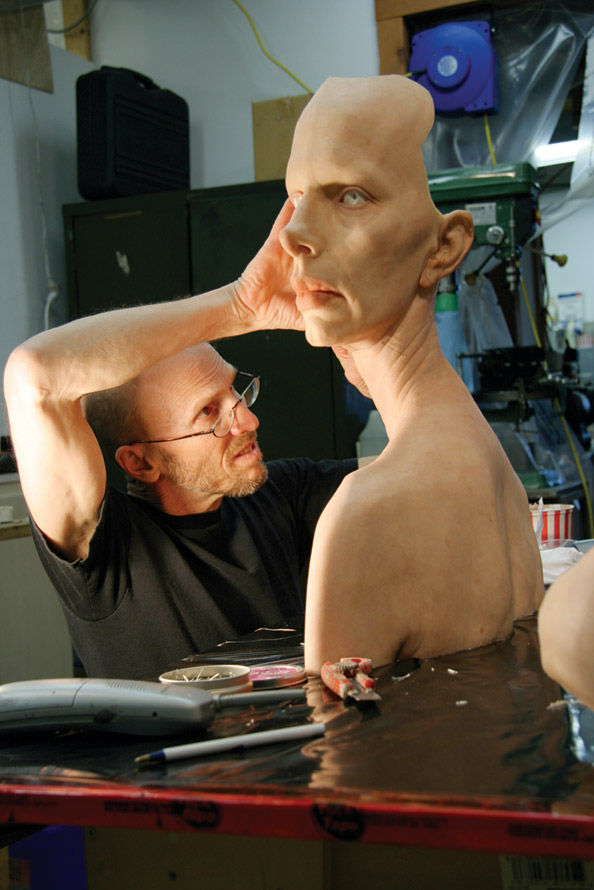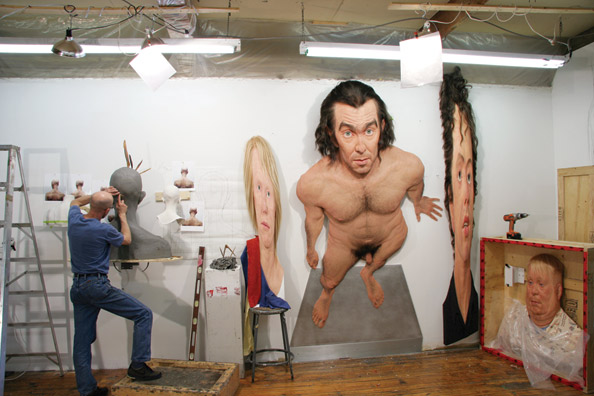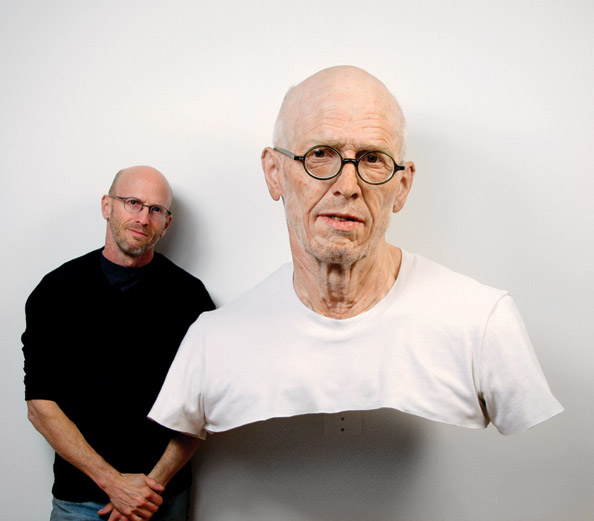Interview with Evan Penny (E.P.) by Emese Krunák-Hajagos (E.K-H.)
Evan Penny: Re Figured
Art Gallery of Ontario
September 20, 2012 – February 20, 2013
E.K-H: How and why did you choose hyper-realistic sculpture?
E.P: I sometimes feel like it chooses me. I am first and foremost a figurative sculptor. In the early days it was all based on direct observation from life (life models) and trying to represent what I saw. From the beginning the question was “what is this?” and “how do describe this”. I discovered that the deeper and more intensively one looks and the more information one gathers and the more complex the understanding, the more uncertain the object becomes. More recently the question “who is this?” has become more central to my inquiry as I filter my process through photography and our relationship to images of ourselves in mass media. One of the by-products of this long process has been a progression towards “realism” but the motivation itself is not realism. I am more interested in the question of representation, and how to make figurative sculpture in an interesting and relevant way. I employ “realism” to that end.
![]() Evan Penny and Aerial #2,2006, silicone, pigment, hair, aluminum, 269x152x33cm, Gian Enzo Sperone, Sent, Switzerland © Evan Penny, 2012
Evan Penny and Aerial #2,2006, silicone, pigment, hair, aluminum, 269x152x33cm, Gian Enzo Sperone, Sent, Switzerland © Evan Penny, 2012
E.K-H: In many ways your hyper-realistic works seem almost unrealistic — even surreal. What is your relationship to reality?
E.P: Whether I am producing portraits of people who exist (L. Faux, Murray) or fictional characters who don’t exist, (No One – In Particular, Stretch). It is all a way to ask: “ how do we understand ourselves? What is real and what is not?” A lot of my process is still based on direct observation but now also focuses on what is overlaid on top of that. There is a profound discrepancy between the ways we experience ourselves (and each other) in real time and space, and how we imagine ourselves (or the other) in a 2-Dimensional image.
I try to situate my sculptures somewhere between those two incongruous realities. One reality is how we live and move in real time and space; how we experience our bodies, how we experience each other in conversation. On the other hand, there is the reality of the image space, how do we imagine ourselves in and through the image. These are the two realities that I work with.
I suspect that feeling of the “unreal” or “surreal” in my work comes from these discrepancies. They are inanimate objects that appear alive. They appear simultaneously real and artificial, organic and manufactured, distorted and plausable.
![]() Evan Penny, Stretch #1, 2003, silicone, pigment, hair, fabric, aluminum, 274x152x33cm. Art Gallery of Ontario, Toronto. Gift of David and Kristin Ferguson, 2008.© Evan Penny, 2012. Photography by Evan Penny
Evan Penny, Stretch #1, 2003, silicone, pigment, hair, fabric, aluminum, 274x152x33cm. Art Gallery of Ontario, Toronto. Gift of David and Kristin Ferguson, 2008.© Evan Penny, 2012. Photography by Evan Penny
E.K-H: Your work uses images from the media – two dimensional images from TV, newspapers or the internet. How do you choose the subjects for your sculptures?
E.P: I don’t directly use images from the media as you suggest. I do reference or allude to them. My subjects are either wholly imagined (fictitious) or based on real people who model for me.
The imaginary characters can be loose composites of images I have encountered in various media, but never copies. How and why I choose them will vary from project to project.
The distortions in my sculptures are also a reference to the kind of distortions we encounter daily in mass media.
In a two dimensional context we readily normalize these distortions. We absorb these extreme representations of ourselves into our sense of who we are without much thought. Yet in real physical space we are very sensitive to any bodily manipulation or anomaly because it can be experienced as a threat to our physical wellbeing. I am interested in this discrepancy. Many of my works start with an encounter with a 2 dimensional image that is distorted by the nature of that particular 2D medium. Blur, multiple exposure, over exposure, stretch, anamorphism are all artefacts of 2 dimensional mediums. They are distortions that we assume belong exclusively to their respective 2-D mediums. I challenge myself with the question: “What will happen if I take a distortion that we assume belongs exclusively to the 2 dimensional realm and bring it over to the 3 dimensional; into the space we physically occupy?”
The experience can be very disruptive and not altogether pleasant, but I think it is ultimately rewarding.
![]() Evan Penny, Murray #3, variation of 3, 2008, silicone, pigment, hair, aluminum., 122x107x33cm. Private Collection Basel. © Evan Penny 2012
Evan Penny, Murray #3, variation of 3, 2008, silicone, pigment, hair, aluminum., 122x107x33cm. Private Collection Basel. © Evan Penny 2012
E.K-H: Can you describe your sculpting technique?
E.P: There are many techniques and processes. Basically my work is a very traditional type of sculpture. I begin by sculpting the figure in modeling clay built over a metal or hard foam armature. It is at this stage that all the shape and detail is established. Once the sculpture is finished it is necessary to make a mould in order to transfer the image from clay to it’s final medium. In my case, that medium is silicone. From the mould, I make the “cast” by building up multiple layers of silicone, applying a preliminary thin layer in which the defining features of the skin: blemishes, moles, freckles and other distinguishing features are painted. In subsequent layers, some of these punctuating features may be elaborated, and deeper red tones are added. The final layer is a hard resin and glass fibre which helps hold the shape.
 Evan Penny and Shelley #2, Variation of 4, 2008, silicone, pigment, hair, fabric, aluminum, 64x61x18cm, Richard R. Singleton of Priddis, Alberta, Canada. © Evan Penny, 2012
Evan Penny and Shelley #2, Variation of 4, 2008, silicone, pigment, hair, fabric, aluminum, 64x61x18cm, Richard R. Singleton of Priddis, Alberta, Canada. © Evan Penny, 2012
Once removed from the mould I can do the final work, adding final colour and then hair. The hair is implanted one by one and represents a significant amount of construction time, which I am happy to say is now largely done by my very able assistants. The Eyes are all designed and made by me in the studio and are the final element to be done. I adapted much of this technology from my 12 year experience in the film industry, constructing prosthetics and special effects make-up.
*Note: In the 1990s Penny worked with a Toronto film company “FX Smith” where he crafted, for example, X Men and the blown apart head of President Kennedy for Oliver Stone’s JFK.
E.K-H: How did the idea of the touring show come up?
E.P: Daniel Schreiber director of Kunsthalle Tübingen came up with the idea of the exhibition. He had encountered my work on various occasions in European venues over the years, and approached Sperone Westwater, my New York dealer with the proposal for the show.
*Note: Schreiber mounted the show titled “Evan Penny Re Figured” which has toured Europe and is now being mounted in Toronto. (Kunsthalle Tübingen, Germany, June 2 – September 4, 2011. Museum Der Moderne, Salzburg, Austria, November 2, 2011 – February 20, 2012. MARCA – Cantanzaro, April 21 –June 30. 2012 Art Gallery of Ontario – Toronto, Canada, September 20, 2012 – January 6, 2013).
E.K-H: In the video made in the Salzburg show you are standing in front of your sculpture, L. Faux: CMYK (2005) and you emphasize distortion. Looking at this larger-than-life-sized depiction of the face and upper torso of a woman, one wants to re adjust the lens of the camera. She has three pairs of eyes, five nostrils and six lips. Please explain this image in more detail.
![]() Evan Penny, L Faux CMYK, 2005, silicone, pigment, hair, aluminum, 153x123x26cm. Private collection, Switzerland. Courtesy of Sperone Westwater, New York. © Evan Penny 2012
Evan Penny, L Faux CMYK, 2005, silicone, pigment, hair, aluminum, 153x123x26cm. Private collection, Switzerland. Courtesy of Sperone Westwater, New York. © Evan Penny 2012
E.P: The idea for that piece comes from the kind of mis registration one sometimes sees in print mediums where the colours are mis aligned creating a kind of multiple exposed image.
*Note: CMYK (cyan, magenta, yellow, black), are the primary colors required for offset printing. Every color in the spectrum can be described on a printed page as a mixture of the three basic process colors; for black, a true black must be added. This tri-colored portrait is a commentary on image formation: the split between two-dimensional printed imagery — which today is entirely digital — and human perception. The work is a critique of how image technologies have re-modeled our vision.)
E.K-H: It is a very interesting sculpture and at the same time challenging to the viewer.
E.P: Yes, that one is probably the most disruptive piece I’ve done. Still it is perhaps one of my most successful too. It kind of defies its own existence. It is a three dimensional image that looks simultaneously two dimensional.
E.K-H: In Panagiota Conversation #2, variation #1, 2008 the talking woman captured in a space depicting the passing time reminds me of when movie reels used to break during the movie — the character’s head seems to be swimming on the canvas. What gave you the idea for this piece?
E.P: “Panagiota” is the name of the woman depicted in this sculpture. It tackles the question “How do you represent time in a photographic image?” and then for me “how do I represent that in an object”. It is a single static image that represents a fragment of a conversation that plays out over an short but ongoing passage of time.
Evan Penny, Panagiota, Conversation #1, Variation #2, 2008, silicone, pigment, hair and aluminum, 69x275x15cm. Courtesy of Sperone Westwater, New York. © Evan Penny, 2012
This work is a collaboration between me and architect and photographer Michael Awad. He designed a camera that allows him to take images like this. It is not like film which is frame by frame, but is a single frame that is moving in front of the lens. It produces an ongoing morphing image where the camera is more or less registering a stream of impressions of the subject as she moves and speaks.
E.K-H: Size seems to be matter in your latest work. Why did you decide on larger than life-size sculptures?
E.P: My early work tended to be smaller than life size. More recently I feel more comfortable working in a larger scale; the details are larger and less “picky” so I can be more dynamic with the detailing. But I also think that it is related to our relationship to media in general. We are surrounded with big images like billboards, posters and even on television we have close ups of the human face sometimes larger than life size. Either way, whether it is smaller or larger, it is more dynamic than life size. It is a way of distinguishing the work from the physical space we actually occupy.
 Evan Penny in his studio. © Evan Penny 2012
Evan Penny in his studio. © Evan Penny 2012
E.K-H: Canadian Art quotes you saying: “We’re starting to comprehend ourselves quite differently, and I’m not sure we fully understand how that is affecting us.” What do you mean?
I think I was referring to digital media in that quote. We have had a hundred years to adjust to photography and the way it has changed the way we depict and imagine ourselves. The digital age is a brand new territory that is transforming before our eyes. We don’t know yet what the full implications of that might be. Whatever the future is, we will adapt to it and be changed by it.
E.K-H: Now that you are an internationally acclaimed artist with shows all over the world, how does it feel? Do you travel a lot? Will you continue living in Toronto?
I will keep living in Toronto, I have no plan to move. I don’t travel that much to be perfectly honest, a few times a year. With this touring show however, I have travelled more frequently. You can see that my work involves a lot of hours so my main priority is maintaining my studio activity here in Toronto. I sometimes feel that I need to protect myself against too much travel. I enjoy travelling but it can be disruptive to my work.
E.K-H: Again Canadian Art quotes you saying: “Something is definitely shifting.” What’s shifting?
I feel as though I am in a transitional phase at the moment but I do not think that necessarily means there will be an obvious shift in the appearance of the work. I think my relationship to the work is shifting, although I am not able to speak clearly to that just yet.
E.K-H: What are your future plans?
I have a large piece Jim Revisited that will be in an exhibition this coming November at the National Gallery of Canada in Ottawa. After that I have no exhibitions planned, so I hope to spend good time in my studio.
Evan Penny and Old Self: Portrait of the Artists as He Will (Not) Be #1, Variation of 4, 2010, silicone, pigment, hair, fabric, aluminum,76x86x59 cm. Private collection, Basel. © Evan Penny 2012
E.K-H: In the AGO’s exhibition, opening on September 20th we can see 30 of Evan Penny’s work from the last ten years, including the artist’s fictional self-portrait as a young man (Young Self, 2011) “Portrait of the Artist as “He Never Was” and Old Self (2011) “Portrait of the Artist as “He Never Will Be” — and everything in between.
Featured image: Evan Penny in his studio. © Evan Penny 2012


1 comment for “Re Figured / Interview with Evan Penny”